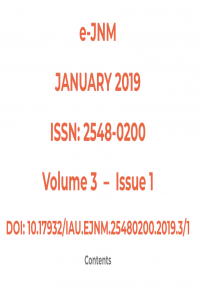Öz
Knowledge and understanding of how Augmented Reality develops an illusion of an alternative reality
that needs to be critically considered with philosophical and technical points of view. Researchers
have been investigating on exploring different techniques to generate enhanced experiences for the
users. In this article, the technological reality scenarios embodied within several Augmented Reality
techniques are explored and a classification scheme is proposed in detail. Additionally, for the
purposes of enhancing the cohesion of an augmented visual content to the actuality, an Augmented
Reality software based on a segmentation using RGB-D camera system that handles the occlusion
problem will also be explained and an enhancement method will be discussed.
Anahtar Kelimeler
augmented reality perception of reality occlusion problem depth camera segmentation
Kaynakça
- Aitpayev, K., & Gaber. (2012), J. Creation of 3D human avatar using kinect. Asian Transactions on Fundamentals of Electronics, Communication & Multimedia, 1(5), pp.12-24. Azuma. (1997), R. T. A survey of augmented reality. Presence: Teleoperators & Virtual Environments, 6(4), pp 355-385. Bodnar, J. L., Candoré, J. C., Nicolas, J. L., Szatanik, G., Detalle, V., & Vallet, J. M. (2012) Stimulated infrared thermography applied to help restoring mural paintings. Ndt & E International, 49,pp 40-46. Brooker, J. (2007), The polytechnic ghost: Pepper’s ghost, metempsychosis and the magic lantern at the royal polytechnic institution. Early Popular Visual Culture, 5(2), pp 189-206. Elmorshidy, A. (2010), Holographic Projection Technology: The World is Changing. Journal of Telecommunications, Vol.2 Issue 2. Fischer, J., Bartz, D. (2006), & Straser, W. Enhanced visual realism by incorporating camera image effects. In Proceedings of the 5th IEEE and ACM International Symposium on Mixed and Augmented Reality, October. pp. 205-208. IEEE Computer Society. Henderson, L. D. (1988), X Rays and the Quest for Invisible Reality in the Art of Kupka, Duchamp, and the Cubists. Art Journal Vol. 47, Iss. 4. Hennessey, J. W., & Mitra, N. J. (2015), August. An Image Degradation Model for Depthaugmented Image Editing. In Computer Graphics Forum, Vol. 34, No. 5, pp. 191-199. https://www.youtube.com/watch?v=D0ojxzS1fCw (Retrived 20.08.2015) J.C. Candore, J.L. Bodnar, V. Detalle and P. Grossel. (2012), Non-destructive testing of works of art by stimulated infrared thermography. The European Physical Journal Applied Physics, 57, 21002 doi:10.1051/epjap/2011110266 Kamat, V. R., & Dong, S. (1901), Resolving incorrect visual occlusion in outdoor augmented reality using TOF camera and OpenGL frame buffer. Proceedings of NSF, 2011, pp 1-8. Kamphius, Carolinen, Esther Barsom, Marlies Sschijven, and Noor Christoph. (2014), Augmented Reality In Medical Education?. Perspect Med Educ 3 (4): pp 300-311. Kan, P. & Kaufmann, H. (2012), Physically-Based Depth of Field in Augmented Reality. In Eurographics (Short Papers), pp. 89-92. Kaufmann, Hannes, and Dieter Schmalstieg. (2003), Mathematics and Geometry Education With Collaborative Augmented Reality. Computers & Graphics 27 (3): pp 339-345. Kolmogorov, V., Criminisi, A., Blake, A., Cross, G., & Rother, C, June. (2005), Bi-layer segmentation of binocular stereo video. In Computer Vision and Pattern Recognition. CVPR 2005. IEEE Computer Society Conference, 2005, Vol. 2, pp. 407-414. Kuhn, G., Amlani, Alym A. & Rensink, Ronal A. (2008), Towards a Science of Magic. Trends in Cognitive Sciences 12.9, 349-354 Lepetit, V., & Berger, M. O. (2000), A semi-automatic method for resolving occlusion in augmented reality. In Computer Vision and Pattern Recognition, 2000. Proceedings. IEEE Conference, Vol. 2, pp. 225-230. Lindberg, David C. (2010), Theories of Vision from Al-Kindi to Kepler. University of Chicago Press McGinnis, Jon. Avicenna. (1981), Oxford University Press. Pal G.K., Pal. P. (2001), Textbook of Practical Physiology. Sangam Books Ltd. Ramö, J., & Valimaki, V. (2012), Digital Augmented Reality Audio Headset. Journal of Electrical and Computer Engineering. Rowe, A. (2014), Designing for engagement in mixed reality experiences that combine projection mapping and camera-based interaction. Digital Creativity, 25(2), pp 155-168. Schweitzer, M. (2014), & Zerdy, J. Performing Objects and Theatrical Things. Palgrave Macmillan. Sidharta, R., Hiyama, A., Tanikawa , T., & Hirose, M. (2006), The Development of Multi-Depth Pepper’s Ghost Display for Mixed Reality System. Proceedings of the 16th International Conference on Artificial Reality and Telexistence--Workshops (ICAT'06). Sinthanayothin, C., Wongwaen, N., & Bholsithi, W. (2012), Skeleton Tracking using Kinect Sensor & Displaying in 3D Virtual Scene. International Journal of Advancements in Computing Technology, 4(11). Tsuji, Shigeru. (1990), Brunelleschi and the Camera Obscura: The Discovery of Pictoral Perspective. Art History 13-3: pp 276-292. Ventura, J., & Höllerer, T, August. (2008), Depth compositing for augmented reality. In SIGGRAPH posters, p. 64. Vera, L., Gimeno, J., Coma, I., & Fernandez, M. (2011), Augmented mirror: interactive augmented reality system based on kinect. In Human-Computer Interaction–INTERACT 2011, Springer Berlin Heidelberg, pp. 483-486. Yoh, Myeung-Sook. (2011), The Reality of Virtual Reality. Proceedings of the Seventh International Conference on Virtual Systems and Multimedia (VSMM’01). Yoon, H. C., & Park, J. S. (2013), Avatar animation using skeleton tracking with Kinect sensor. International Journal of Advancements in Computing Technology, 5(12), p.339.
Ayrıntılar
| Birincil Dil | İngilizce |
|---|---|
| Konular | İletişim ve Medya Çalışmaları |
| Bölüm | Araştırma Makalesi |
| Yazarlar | |
| Yayımlanma Tarihi | 1 Ocak 2019 |
| Gönderilme Tarihi | 15 Kasım 2018 |
| Kabul Tarihi | 15 Aralık 2018 |
| Yayımlandığı Sayı | Yıl 2019 Cilt: 3 Sayı: 1 |
All site content, except where otherwise noted, is licensed under a Creative Common Attribution Licence. (CC-BY-NC 4.0)


